


You haven’t really made friends with a croissant until you’ve met one coming out of the oven. Oh, so light, crisp on the outside, tender inside, and fragrant with ever-so-slightly toasted butter. It’s an experience that stays with you.
“But I don’t work in a bakery,” you’re thinking. “How will I ever know this moment of which you speak?”
You can make croissants yourself, that’s how. I expect some of you may shrug and decide to do your mousing around someplace else at this point. But if you’ve ever wondered how such an amazing baked good comes to be, or entertained the wish to make croissants yourself, stay with me and I’ll show you how.
First a little back story.
I spent 5 months working the overnight bakeshop shift at the New England Culinary Institute.
Class began at 10 p.m., and was done by 6 a.m., just before the bakery, La Brioche, opened. The overnight class was responsible for creating all the morning pastries for the case: croissants, Danish, muffins, cookies, quick breads, pies, rolls, and cakes. As I remember it, the time spent there was a lot like the Twilight Zone. The first 3 hours were no problem. They were spent scaling, mixing, scooping, dividing dough, proofing, running the first product through the ovens.
Somewhere around 3 a.m. was what I called “the witching hour,” where most mistakes were made, or your body and brain seemed to take a vacation from each other. Perhaps it had to do with the fact that “Mmmmmbop” was played on the radio EVERY SINGLE NIGHT at that time. Hard to say.
What brought me back from the witching hour were the croissants. Especially the ham and cheese. Never underestimate the redemptive power of melty cheese surrounded by buttery layers of pastry.

We made our croissants with the aid of the ultimate pastry power tool: it’s called a sheeter. It functions like a rolling pin on steroids. Any dough you put on one side is put under a stainless steel roller in the center, and comes out the other side thinner than it went in. It’s a very efficient way to make laminated doughs.
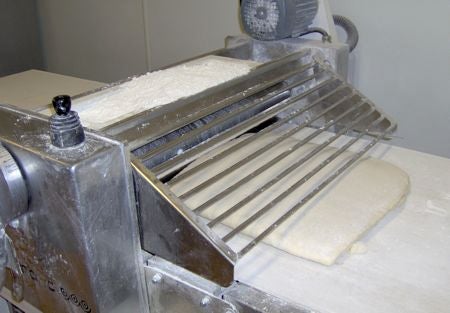
Huh? Isn't laminate a kind of flooring? Laminated in this case refers to layers, and is how pastry comes to be.
The short version is this: A flour/egg/water/and-or/yeast dough is mixed and allowed to rest. Then butter is worked so that it’s plastic (flexible), mixed with some flour to stabilize it, and enclosed inside the dough.
From there, the package is rolled out and folded to create distinct layers of dough and butter. When this dough is baked, the butter layer expands and separates the dough layers, creating the ultimately flaky product we know as a croissant.
You can laminate a dough that has yeast (baker’s croissants, or croissants de boulanger) or one with no yeast (puff pastry, used for croissants de patissier). If you wanted dough to make vol au vents, or turnovers, you’d use puff pastry. If you want to make croissants or Danish, you’d use the dough I’m going to show you. The techniques are the same; the ingredients are slightly different.
Ready to go? Let’s make Baker’s Croissants.
First, we’ll put the dough together. Break 2 large eggs into a measuring cup, and add enough water to make 2 cups of liquid.

Place this in a mixing bowl or the bucket of your bread machine. Next, add 1/4 cup of sugar; if you plan to make only savory croissants, you can leave half or all of this out.
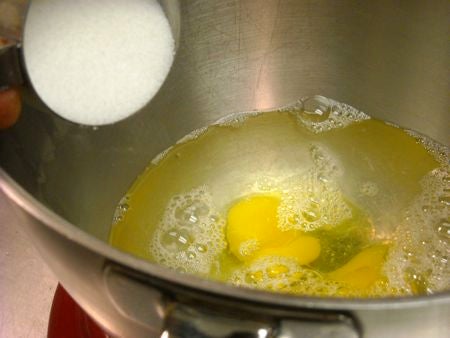
Add a scant tablespoon of salt, 2 teaspoons of instant yeast...
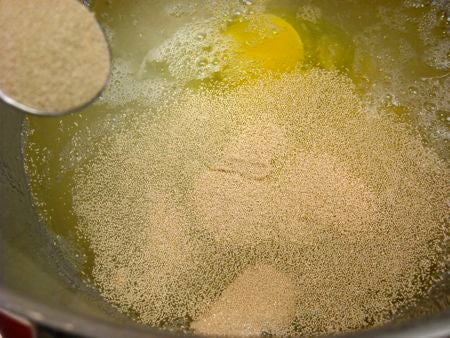
...and 5 1/2 cups (23 1/2 ounces or 1 pound, 7 1/2 ounces) of flour. Measure out another 1/2 cup of flour and keep it ready, in case you need to adjust the consistency of the dough. This is what recipes mean when they give you a range with flour amounts: start with the lower number, and use the rest only if you need it.
You can also add 1/2 cup of dry milk powder; mine has clumped up a bit, so I’m putting it through a strainer to break up the lumps.
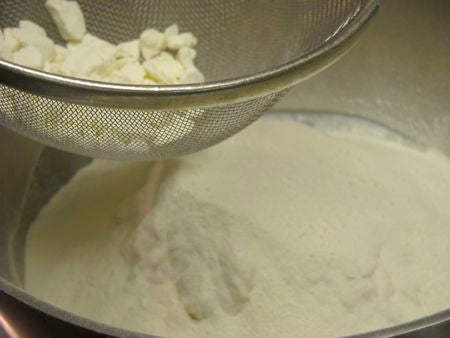
This is optional, but makes the dough a bit richer. Finally, 2 tablespoons of butter, either very soft or melted and cooled. Leave the rest of a pound of butter out on the counter; you'll be using it shortly. Mix up the dough...
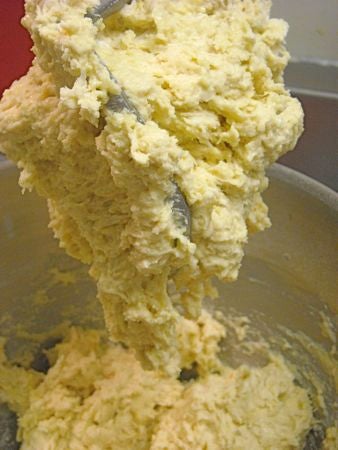
...and use part or all of the additional 1/2 cup of flour to adjust the texture if the dough stays tacky after being kneaded for a few minutes.
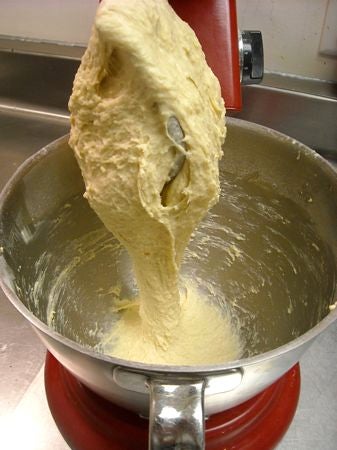
This dough is too sticky; I'm going to adjust it with 2 to 3 tablespoons more flour from the reserved half cup I measured out in the first place.
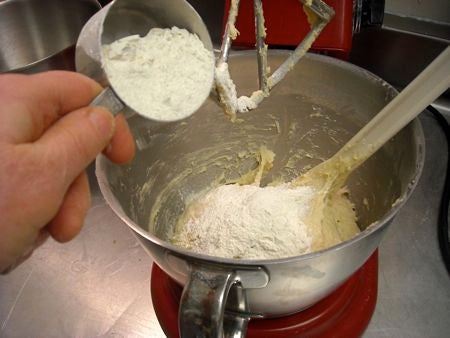
That's more like it. The dough is still soft, but it's smooth and doesn't stick when I touch it.
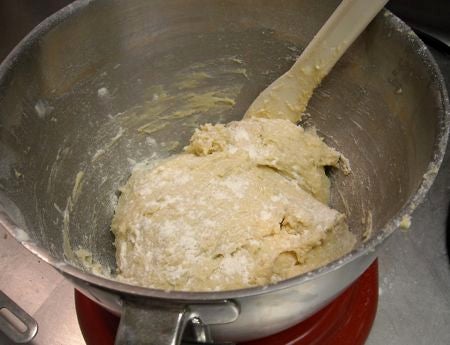
Sprinkle the dough with some flour, and sprinkle a little more flour into a large plastic bag. Put the dough inside it.
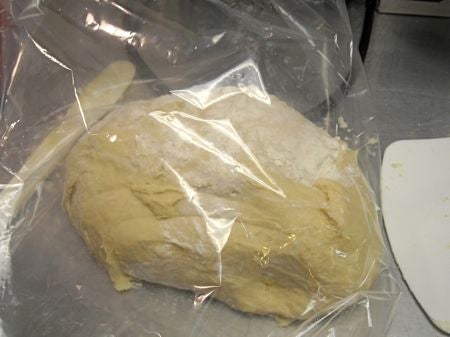
Pat or roll it into a square-ish shape (this will help you later). Put the bag on something flat (it's kind of floppy), and refrigerate for 30 minutes. If you’ve used your bread machine to mix and knead the dough, take it out as soon as the kneading is done, put it in a bag, and refrigerate it.
However you’ve mixed your dough, you don’t want to give it a full first rise. The yeast will have plenty of time to grow during all the time the dough is being rolled and rested.
Next we’ll make the butter inlay. When I had a sheeter, I just pounded the butter to make it malleable, spread it into a uniform slab, and rolled it in. When I’m making croissants by hand, I add some flour to the inlay to keep it more stable; it doesn’t all melt and run out in a puddle when the finished product is baked.
Measure out another 1/2 cup of flour. Sprinkle some of it on a piece of parchment paper. Unwrap the rest of the pound of butter you've kept out, and put it (the butter should still be cool to the touch, but not rock hard from the fridge) on top of the flour on the paper. Sprinkle the top with some more flour and cover with plastic wrap.
Now for a little therapy. Give the butter some whacks with a pastry or rolling pin to make it flexible.
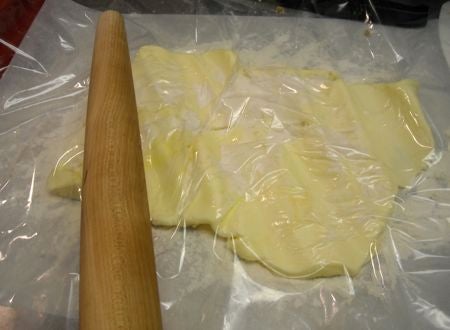
Now put it in the mixer with the remaining measured flour and set up your paddle. Mix the butter and flour at low speed, just enough to make the mixture smooth. You don’t want to beat air into the mixture.
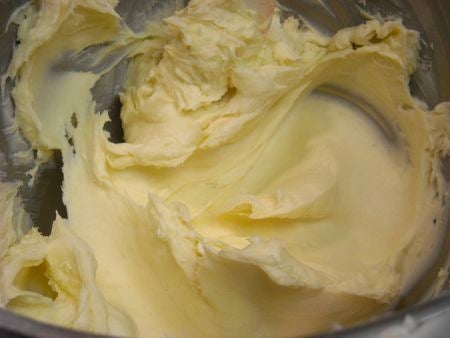
Scrape the butter back onto the parchment and spread it into an 8” square. Make sure the corners and edges are tidy: it makes a difference, all the way through the process. Cover and chill the butter for 20 minutes, until it firms up (but not too far).
Let the fun begin! You’ll need a 24” ruler or measuring tape; flour for sprinkling; a dry pastry brush; a small bowl of water and a wet pastry brush, and a rolling pin.
Dust your work surface with flour, and put the dough on it. Pat the dough into a 12” square. Be neat. Now put the butter square in the center, turned 45 degrees, so it looks like a diamond in the square.
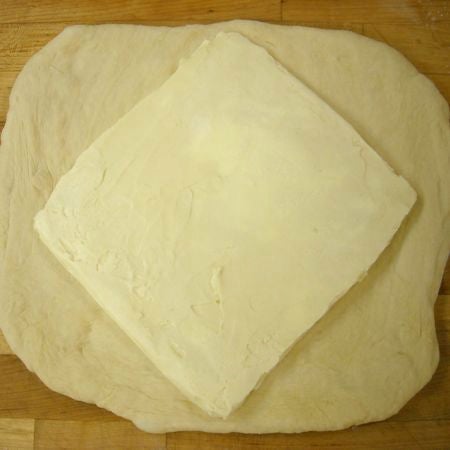
Take the top corners of the dough and put them in the center, pinching together the seam.
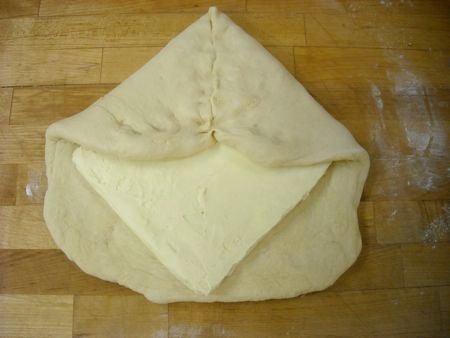
Repeat with the bottom corners so the butter is completely enclosed.
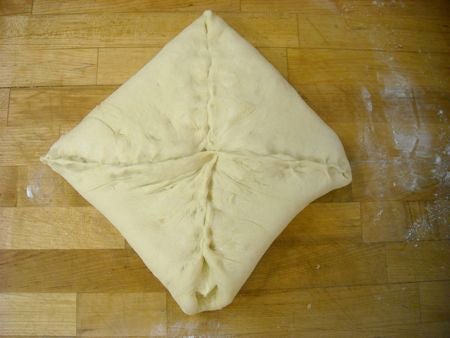
After pinching that last bit of the seam closed, sprinkle the packet with a little flour, and tap it with your rolling pin, to encourage it to elongate.
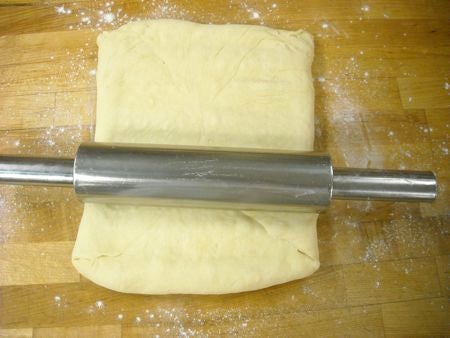
Roll the dough into a rectangle 20” long by 10” wide (the width of a standard rolling pin barrel), stopping to free the dough from the work surface periodically, sprinkling a little flour underneath if necessary. Once the dough is long enough...
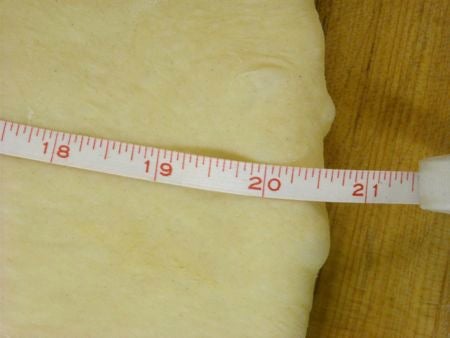
...brush any excess flour off the top, and fold the bottom edge 1/3 of the way up. Line up the edges neatly.
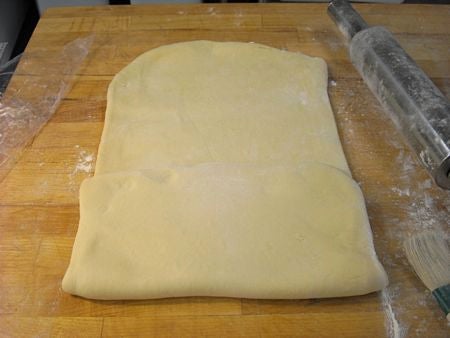
Fold the top down.
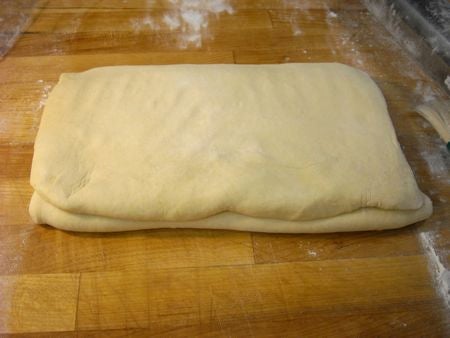
Turn the dough packet 90 degrees, so it looks like a book you could open.
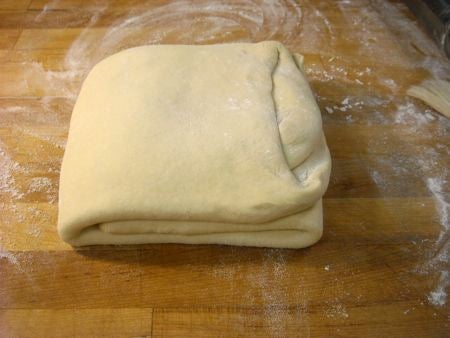
If the dough is still relaxed and flexible, repeat the steps you just took: roll out, brush off, fold in thirds.
Once that’s done, you can mark the dough with a couple of dimples that record that you’ve given it two turns.
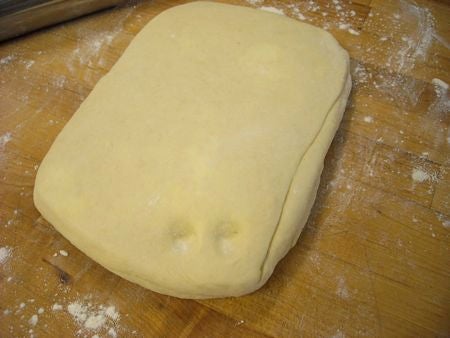
Now it’s time to let your dough have a nap. Sprinkle it with flour and put it back in its bag. Let it rest in the refrigerator for at least half an hour, so the gluten in the dough can relax.
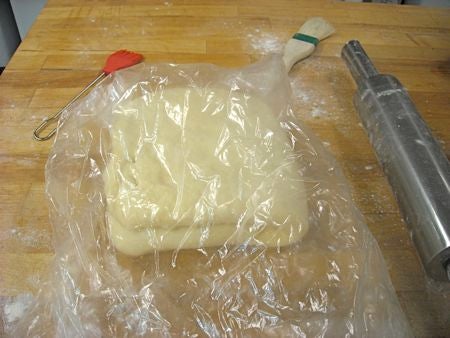
After the dough’s rest, give it two more turns just as you did the first time. Flip the dough over between the first and second turns to even things out.
Hint: as you're folding the dough, be fussy about lining up the corners. Use a little water to tack them in place, if necessary, so the layers don't slide around as you roll the dough.
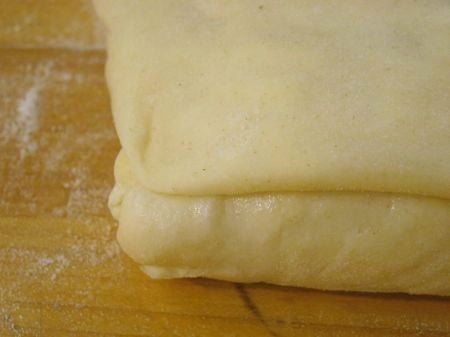
Rest the dough again. A small aside here. This is one instance where more is not better. After you've made 4 turns, you're going to feel pretty confident. You're just hitting stride with this business, and you think, "if 4 is good, how many more layers will I get with 6? My croissants will be sky high!" Check this picture out. Which of these two croissants had more turns?

Answer: the one on the left had 6 turns, the one on the right only 4. For more distinct layers, better flake, and by the way, less work, 4 turns works.
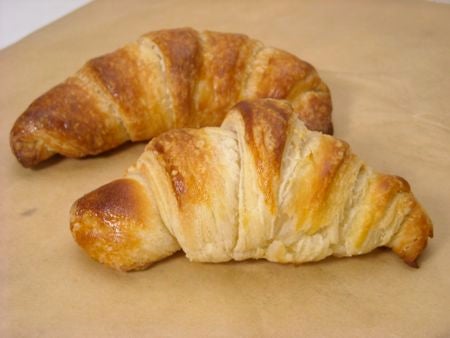
By the way, the one in front needed more time in the oven than it got. See how there's white dough at the overlap? That means there's still raw dough inside.
I know this is a long piece, but here's something you should know. Even when this dough isn't perfect, it's still mighty good.
The first batch I made for this blog was somewhat abused by circumstance. I had a number of other things demanding my time while I was trying to get it made, and as a result I alternated between pushing it (rolling it too cold) and neglecting it (leaving it out too long).
The result? Dough that looked like cellulite when I rolled it. Here's how it looked after dividing the batch in half.
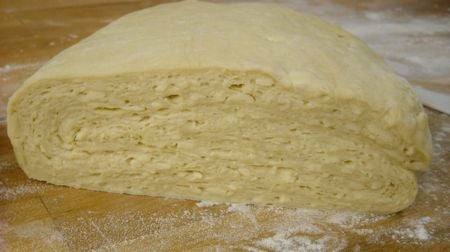
While you can see that the butter layers aren't contiguous, and the yeast layer is a little spongy-looking, this dough still baked up pretty well. It's the dough that I used to make the ham and cheese croissant you saw above. So even if your dough doesn't look fashion-model perfect, don't be discouraged.
Back to our project.
After you’ve finished your turning and folding, let the dough rest in the refrigerator for at least 4 hours. Overnight is better. You could also divide it in half and freeze half at this point.
We’ll use both halves here, so I can show you more things to do with it. You can see it's rather poofy-looking, because the yeast has been working.
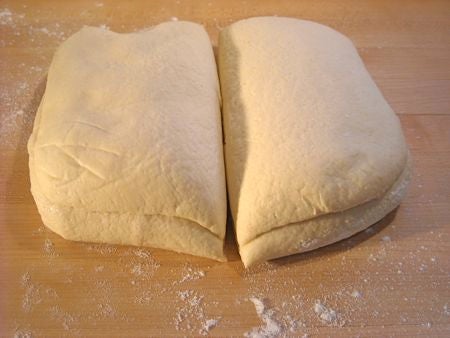
I'll put half the dough back in the bag and refrigerate it; we'll see it in action in a bit. Roll the remaining dough into a 12” x 18” rectangle.
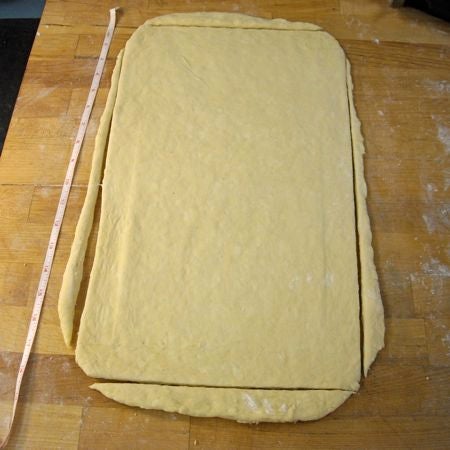
Pick it up and dust the work surface with flour underneath the dough as you're doing this; the dough should move freely over your work surface as you roll. Trim the very outside edge of the dough with a straight edge and a pizza cutter. This takes off the sealed edges of the dough that could inhibit its "poof."
Save the scraps; we'll play with them later. Just tuck them under some plastic for now.
Next, cut the remaining dough in thirds lengthwise and in half across the middle.
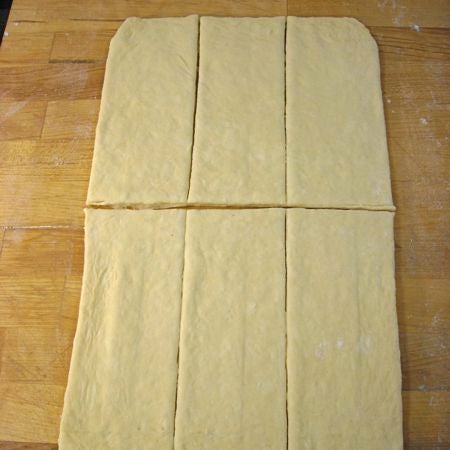
Cut each of these rectangles diagonally in half.
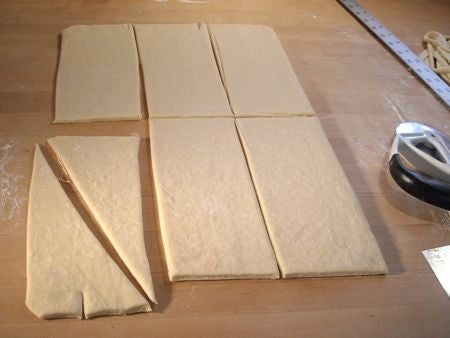
Put a 1/2" notch in the center of the triangle's short side. This will help the croissant to curve once it's shaped. Set up all of your pieces of dough.
The idea when rolling croissants is to roll them up from the bottom, and to end up with the point of the dough neatly underneath the finished product. To ensure this, it's a good idea to stretch them out just a bit.
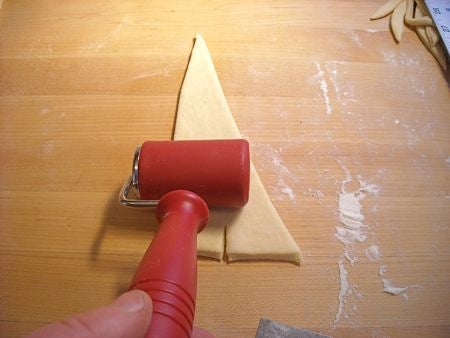
Roll the dough up like this:
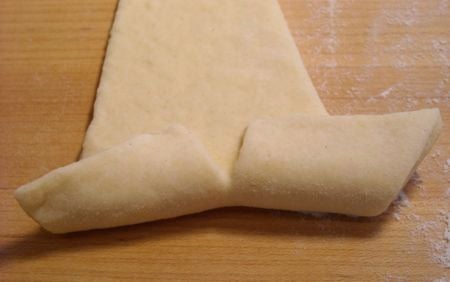
Keep going...
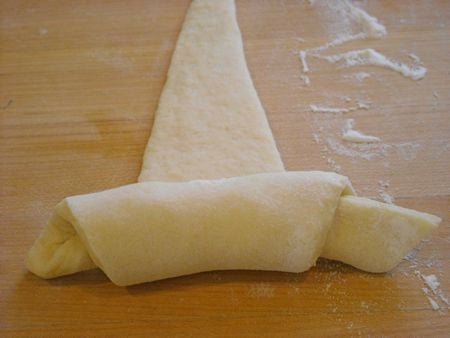
You can put a dab of water on the tip to help it stay put when you get to the end:
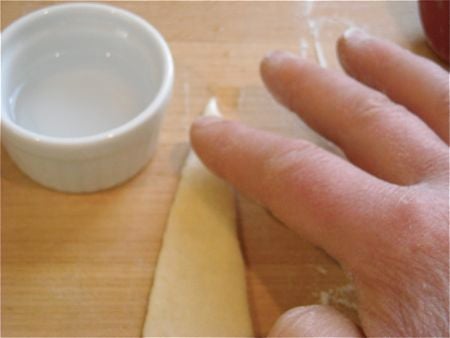
All rolled up.
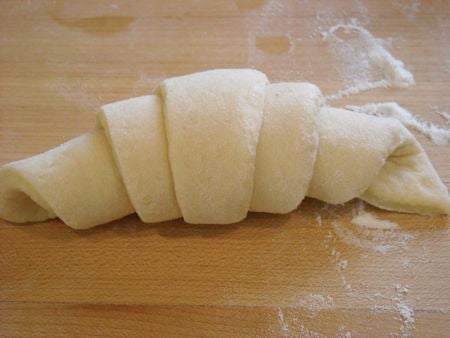
There are two things to notice here. The point of the dough is underneath the croissant, and the “ears,” or open points of dough at the ends, are facing up. That's what you're aiming for. But we're not quite done, because this is called a croissant, not a droite. Gently curve the ends toward each other.
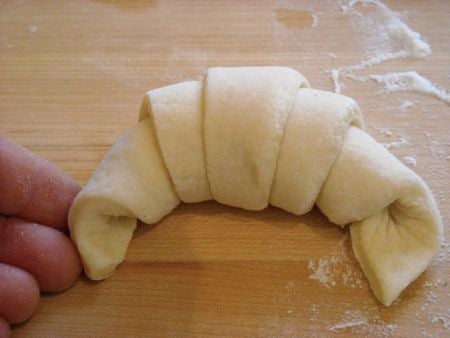
You could freeze the croissant at this point (I'd recommend a rigid plastic container with a lid) for up to 2 weeks. Thaw in the refrigerator overnight before egg-washing and baking.
A nice riff on plain croissants is a little cinnamon filling. On the overnight shift we sprinkled some cinnamon-sugar inside before rolling the dough; since coming to the land of Arthur, though, I've discovered Baker's Cinnamon Filling. I'm putting about a teaspoon of it in this croissant before rolling it up.
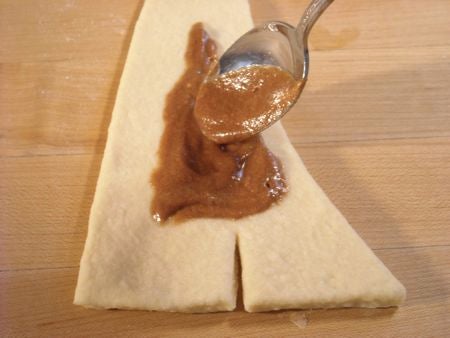
You can use our pain au chocolat sticks, too.
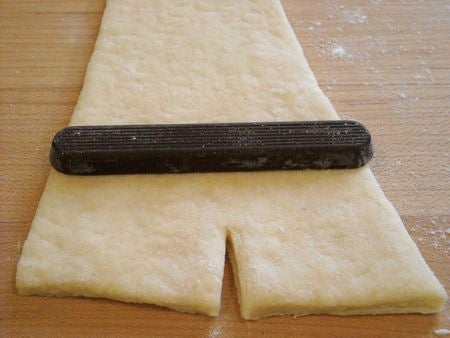
After you've formed all of your croissants, put them on a parchment-lined baking sheet and refrigerate them for half an hour; this is to let the butter firm up again, so it doesn't run right out when they're baked.
We're going to take the other half of the dough and fill it, too. Roll it out the same way as the first half, including trimming the edges. This time, cut the rectangle in thirds in both directions. This should give you nine 4” x 6” pieces of dough.
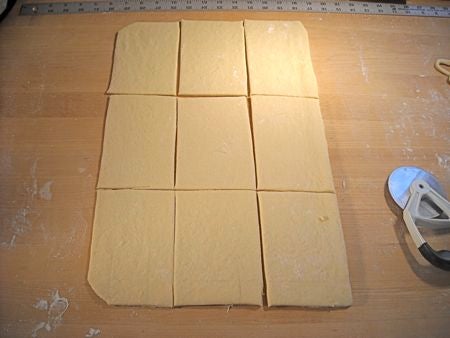
Take a piece of dough and turn it sideways. Place half an ounce of Swiss cheese on one end, and the same amount of ham on top of that.
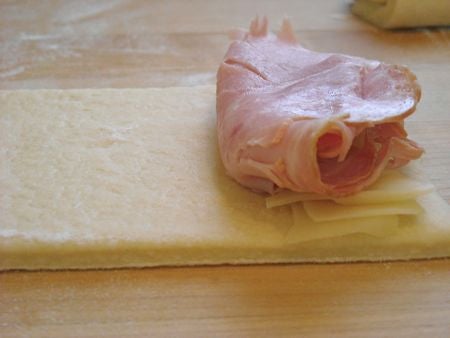
Fold this end 1/3 of the way over.
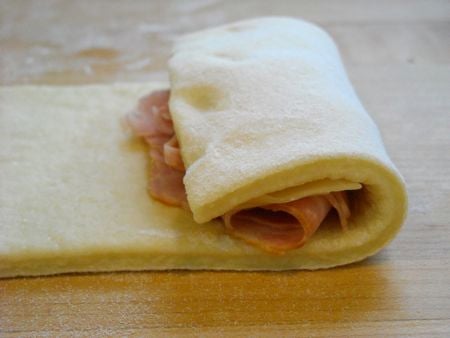
Fold over again, so the curve on the right is just past the edge on the left.
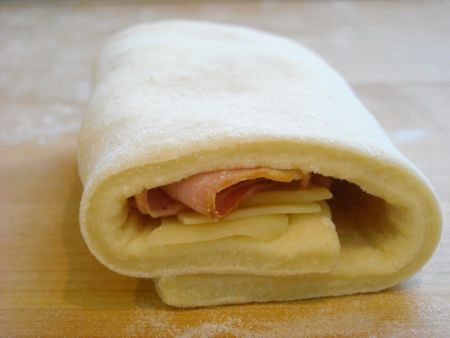
Press gently down on top, to seal things together.
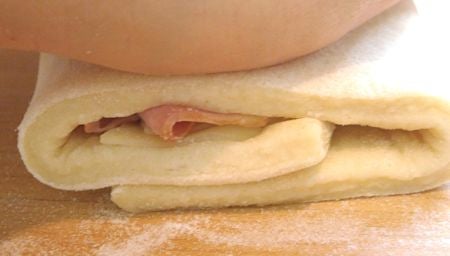
You can do this with other fillings, too. Spinach is good. If you look closely, you can see that I wet the left edge of the dough to help seal the seam.
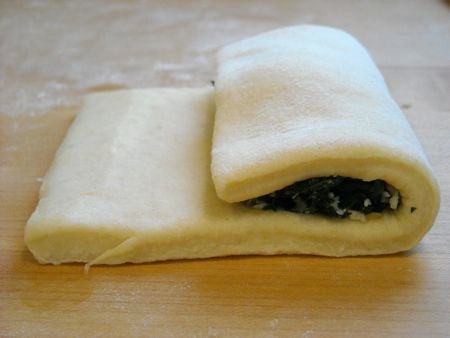
Chocolate, of course, is wonderful.
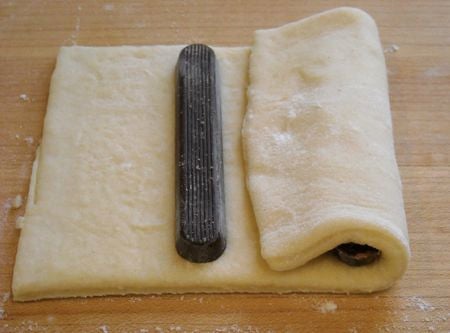
This is my idea of treasure:

Refrigerate your filled croissants for 30 minutes. Or once again, you could freeze at this point; you could have a stash that dresses up your weekend breakfast for weeks!
Remember that little scrap pile? At the bakery we collected them all, then made filled coffee cakes from them, but at home there aren't that many.
I have a little cinnamon filling left, so I'm going to spread it on one strip, put another on top, and twist them together into a round to make a Danish.
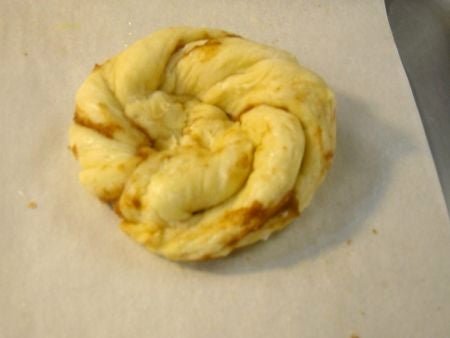
I'll put a spoonful of preserves in the center before baking this off.
Time to bring this project on home.
Take the croissants out of the refrigerator, and let them warm and rise for 60 to 90 minutes at room temperature. They should expand noticeably, and when you gently press one with your finger, the indentation should remain.
Towards the end of the rising time, preheat the oven to 425°F. If you happen to have a convection oven, this is a good place to put it to use. If using convection, set the oven to 400°F. Those of you who have been following us on Facebook know that I have a brand new set of Bosch ovens in the test kitchen. They're heating up for their inaugural bake right now:
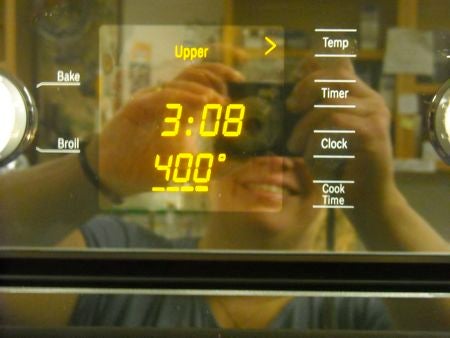
Put the croissants on baking sheets, leaving plenty of space between them; they're going to expand quite a bit during the bake. Time for the pastry brush and some egg wash. My new favorite thing to use here is cartons of egg substitute instead of breaking eggs and whisking them. Here's why.
I can pour out exactly the amount I need.
No globs of egg white suddenly puddling on top of things, then sliding off and gluing whatever I'm baking to the pan. And it saves time.
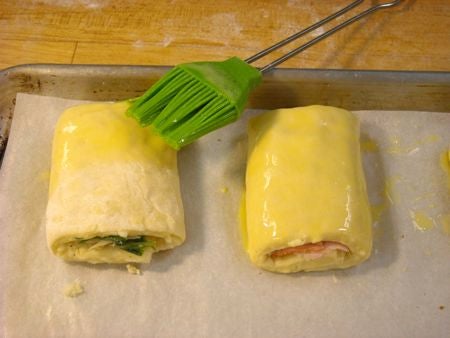
Into the oven they go. The window on this oven is huge. It's also so clear that you don't need to open the door to see what's going on inside.
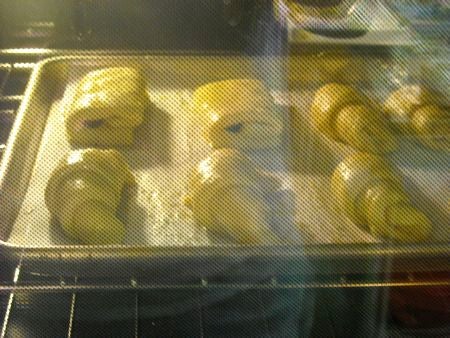
Cool, or what?
Bake the croissants for 15 minutes; then turn the oven temperature down to 350°F for another 15 minutes. They should be a deep golden brown, even where the dough overlaps itself.
The moment is here. Time to tear in. Make friends with one of the most heavenly things you can do with butter and flour. Meet your first warm croissant.
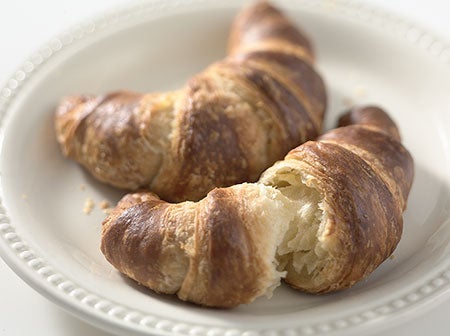
Please read, bake, and rate our recipe for Baker's Croissants.